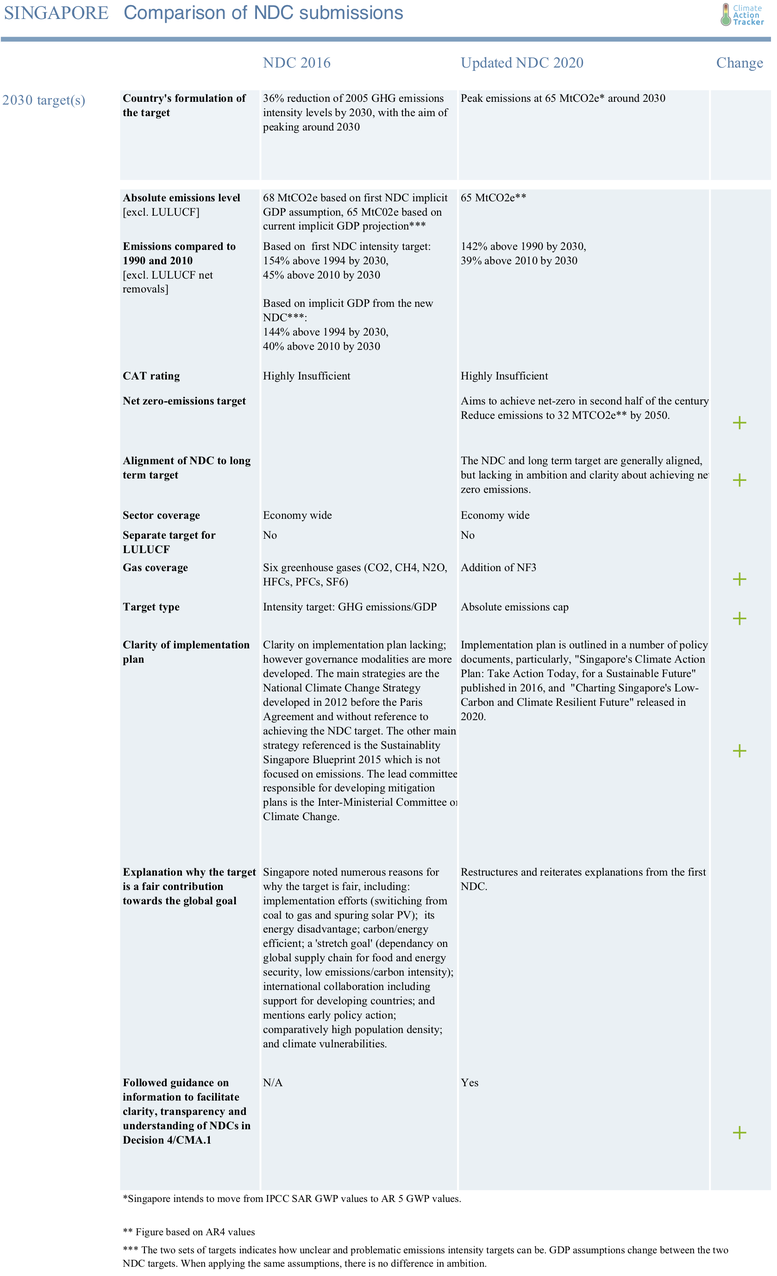CAT Climate Target Update Tracker
Singapore
Summary
Singapore’s NDC update does not further limit GHG emissions beyond its first NDC.
Singapore updated its NDC in March 2020. While it improved the form of its target, moving from an emissions intensity target to an absolute cap on emissions and adopting the latest IPCC reporting guidelines, as well as gas coverage, the level at which Singapore will limit emissions remains unchanged. Its CAT rating remains as ‘Highly Insufficient’. Singapore should scale up its climate action and re-submit its NDC update.
Scroll down for a detailed analysis of Singapore’s NDC update or click the button to view the latest CAT assessment for Singapore.
CAT analysis of NDC


On March 31, 2020 Singapore submitted its updated NDC to the UNFCCC. The National Climate Change Secretariat notes that the update is ‘consistent with Singapore’s existing 2030 NDC’.
The purpose of the NDC update process is to scale up climate action and reduce GHG emissions. In 2015, Governments formally acknowledged their collective commitments under the Paris Agreement would not meet the goal of limiting warming to 1.5°C, which resulted in planning for NDC updates in 2020. Updating an NDC without further limiting GHG emissions undermines the Paris Agreement update process and breaks the agreement’s requirement that each successive NDC should represent a progression in climate action.
The CAT rating has remained ‘highly insufficient’ for the updated NDC. This rating indicates that Singapore’s climate commitment in 2020 is not consistent with holding warming to below 2°C, let alone limiting it to 1.5°C as required under the Paris Agreement. This means Singapore’s climate commitment is not in line with any interpretation of a “fair” approach to the Paris Agreement’s 1.5°C limit.
Singapore is on track to overachieve its updated NDC based on its current policies. If one were to recalculate its updated NDC based on current policies, it would decrease 12% from 65 MtCO2e to 57 MtCO2e in 2030. Therefore, Singapore will need to go beyond this level in order to show a true progression in scaling up climate action.
Setting an absolute target is a positive step, but Singapore also needs to increase its ambition. An absolute target provides transparency by setting a concrete level of emissions that will be reached, and allows for easy country comparison. Moving to an absolute target is commendable as absolute emissions do not depend on other factors such as GDP.
The implicit assumptions about GDP in 2030 vary between the first NDC and the updated NDC. The targets are both intended to be a 36% reduction in emissions intensity in 2005 levels. However, as the updated NDC differs in terms of moving to AR5 GWP and including NF3 as an additional gas, GDP assumptions must have changed for the targets to both amount to a 36% reduction, highlighting how unclear and problematic emissions intensity targets can be.
The NDC update includes Nitrogen Trifluoride (NF3) gas, in addition to the greenhouse gases already covered (CO2, CH4, N2O, HFCs, PFCs, SF6). It is unclear from government data how much NF3 gas contributes to Singapore’s overall emissions as it is not included in the latest inventory. However, the US EPA estimates NF3 in 2020 to be 0.37 MtCO2e and 0.46 MtCO2e in 2030, which is equivalent to 0.7% of 2020 emissions under the CAT current policy scenario, and 0.8% of 2030 emissions. If we added the NF3 to the first NDC calculations, the difference is less than 0.5%. Including NF3 in the target provides full gas coverage and transparency. However, as NF3 accounts for less than 1% of emissions, its inclusion does not increase climate action.
The updated NDC has a clear lead committee and references the documents that outline Singapore’s implementation plans. The Inter-Ministerial Committee on Climate Change (IMCCC) is responsible for leading government mitigation efforts.
Governments agreed in Paris to set long term strategies by 2020. Singapore has published its Low Emissions Development Strategy (LEDS) for 2050 and beyond. The updated NDC and long-term target are broadly aligned, however, there is not enough clarity regarding the pathway to net zero emissions. The long-term target is based on halving the updated NDC target, i.e. to halve Singapore’s peak emissions levels by 2050 (32 MtCO2e by 2050 in AR4 GWP values), and reach net zero emissions by the second half of the century.
Links
Stay informed
Subscribe to our newsletter
